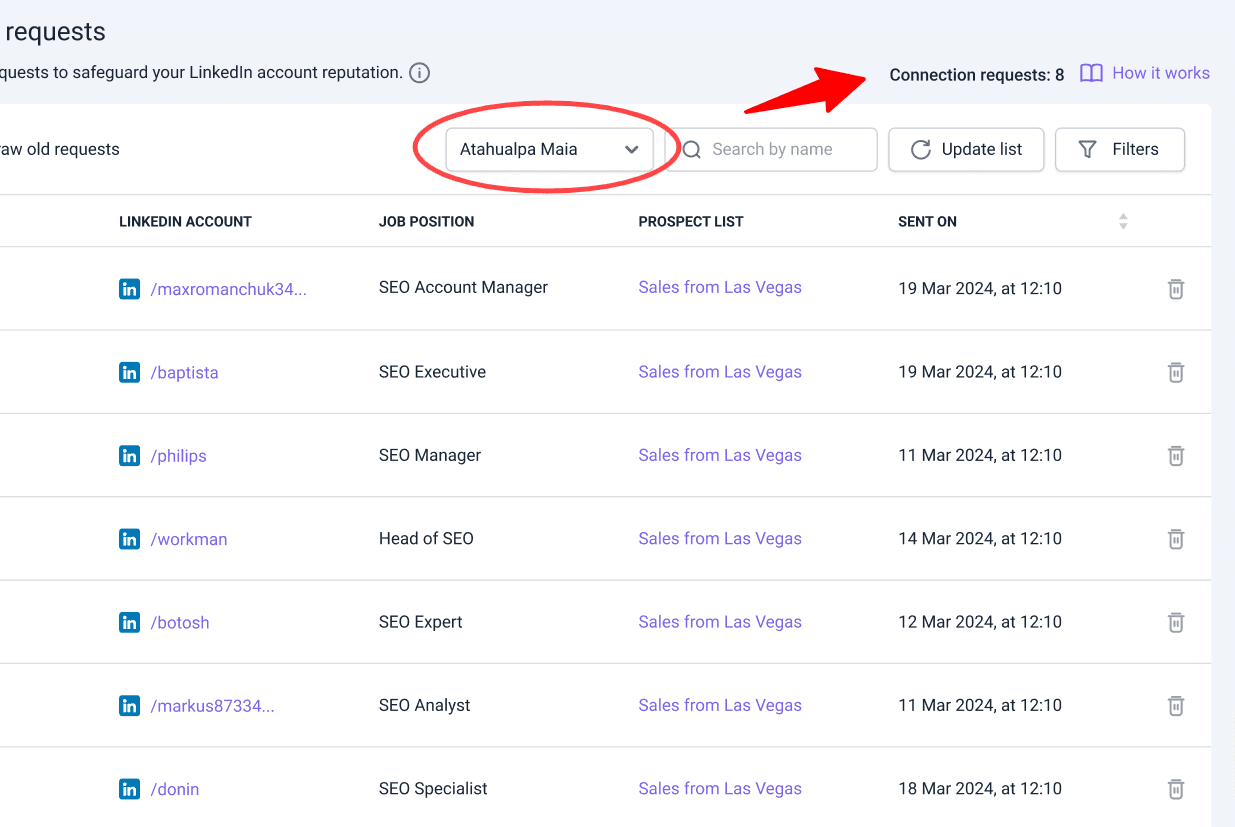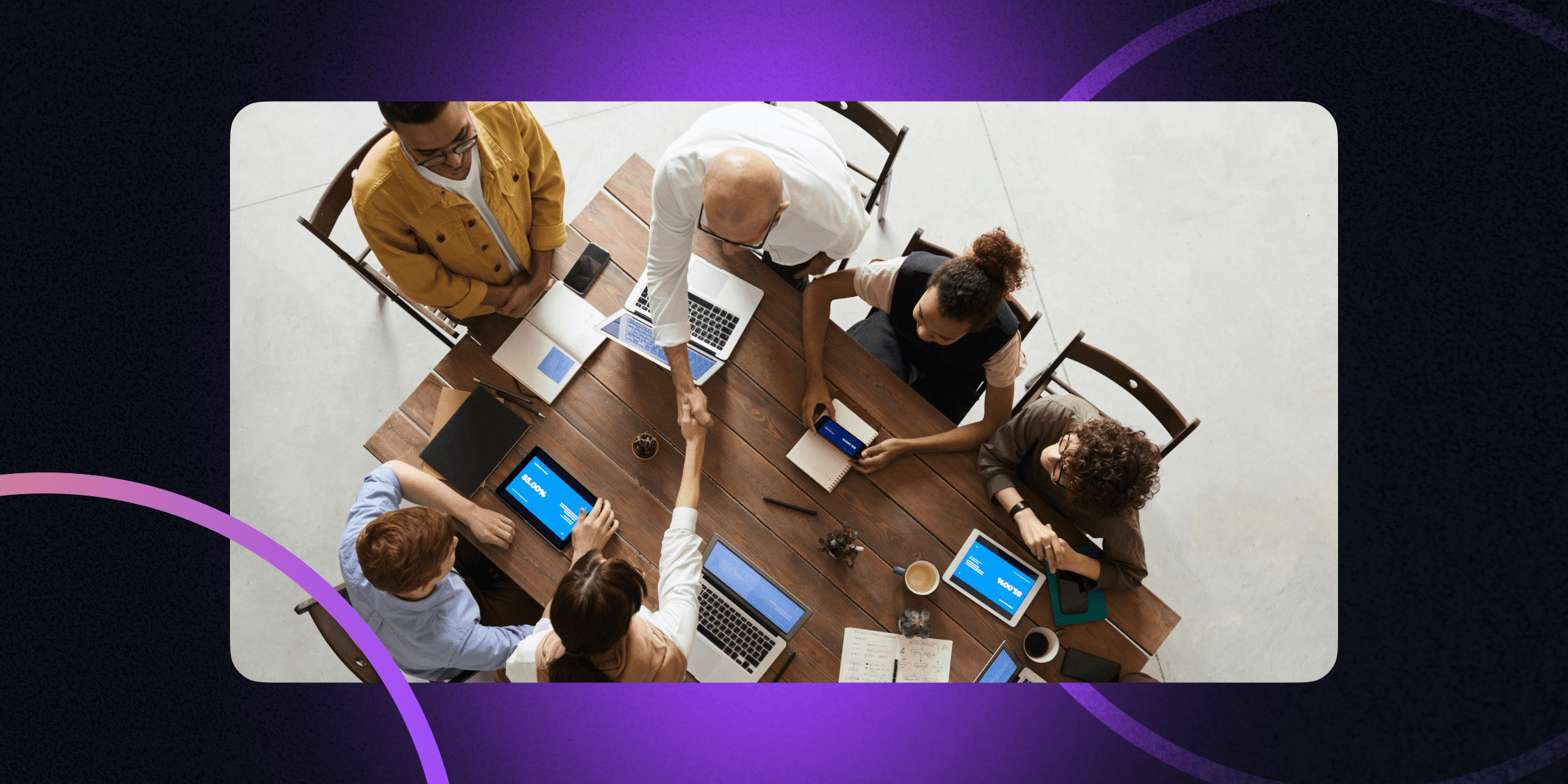TL;DR
A LinkedIn connection message is a note you can add when sending a connection request. It’s brief, limited to 300 characters, and used to justify why you’re trying to connect. Generally, there are 3 types of LinkedIn connections: 1st-degree, 2nd-degree, and 3rd-degree.
Generic LinkedIn connection messages don’t work anymore. That’s why we’ve prepared this comprehensive guide with actionable tips and 20+ templates. Use it as a reference point to ensure your messages always sound relevant and personalized.
To collect leads from LinkedIn, use the LinkedIn Email Finder extension. Alternatively, you can use Email Finder to find emails on any other website.
With over 1 billion users, LinkedIn opportunities are unmatched. But people seem to have a solid grasp on that, turning the platform into a highly competitive space.
Connecting by simply adding a note won’t seal the deal these days. Effective outreach strategies speak to leads’ pain points and interests.
This article is on a mission to provide you with a guide for writing quality LinkedIn connection messages that feel both personal and drive engagement.
Outline:
What is a LinkedIn connection request message?
A LinkedIn connection message is basically a note you can add when sending a connection request. It’s short, limited to 300 characters, and serves to explain the reason you’re trying to connect.
Such messages are an excellent opportunity to establish a rapport, but it’s crucial to keep in mind they are not direct sales pitches. When writing your notes for LinkedIn connection requests, focus on making them personalized and genuine.
How to send a connection request on LinkedIn?
Connecting with people on LinkedIn is easy. Just go to the profile of the person you want to connect with and click the Connect button.
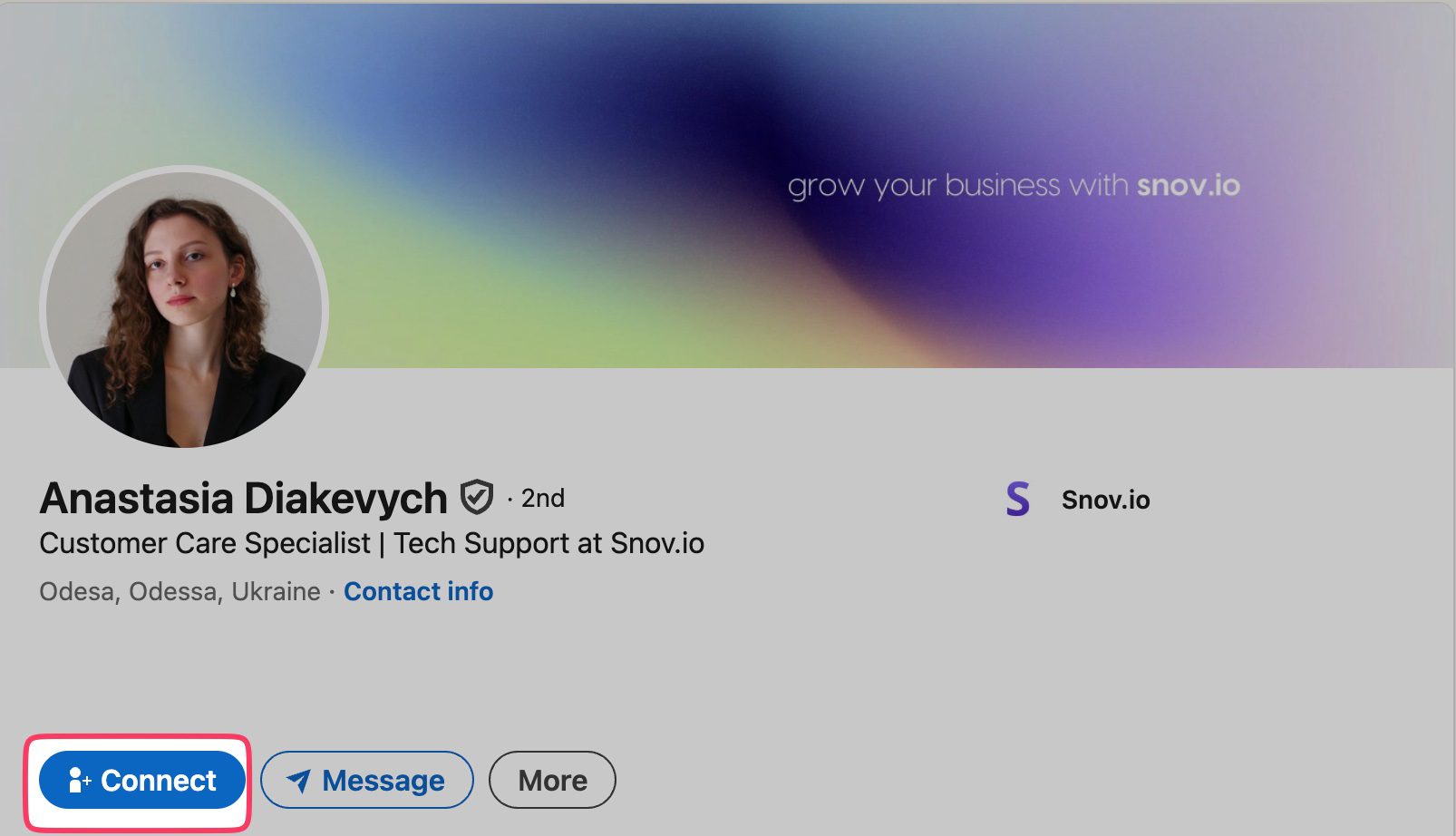
Then, click “Add a note” and create a short and personalized message.
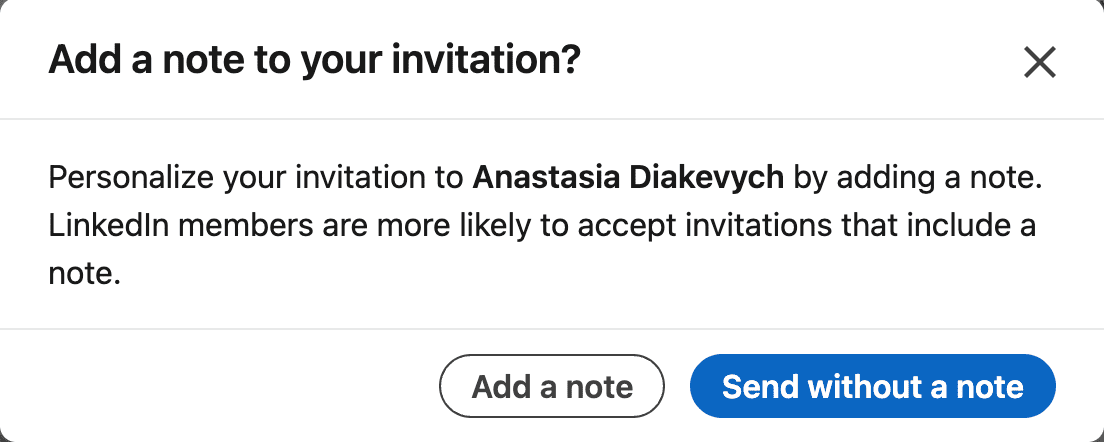
What are the different types of LinkedIn connections?
Connection types are used to identify your level of closeness with other people on LinkedIn.
Generally, they can be split into three categories:
- 1st-degree connections – profiles you’re already connected with. They are part of your network, so you can contact them via regular LinkedIn messages.
- 2nd-degree connections – these people are outside your direct network, but they are tied to someone from your immediate connections. You can’t just directly text them, so have your templates ready if you plan to send a connection request.
- 3rd-degree connection – these LinkedIn profiles are only connected with your 2nd-degree connections. To contact them, you need to send a connection request and have it accepted as well.
|
📌 Expert tip We recommend sending connection requests only to people relevant to your industry to keep your LinkedIn reputation safe. Failing to keep your outreach relevant impacts your acceptance rates and can lead to a temporary suspension or even ban. You can use LinkedIn outreach automation tools to avoid this headache. For example, Snov.io’s intelligent prospecting software keeps your outreach in check with smart safety limits, built-in proxies, LinkedIn account rotation, and much more! |
How to write a connection message on LinkedIn
What makes a good LinkedIn connection message? Clearly, no approach works universally, so testing is vital. But there are a few essential tips that you can use as a reference point to make your efforts more guided.
In the context of LinkedIn connection messages, relying on the SUCCES framework is a good practice. Basically, this approach, introduced in the Made to Stick book by Chip and Dan Heath, is all about making your messages memorable in people’s minds:
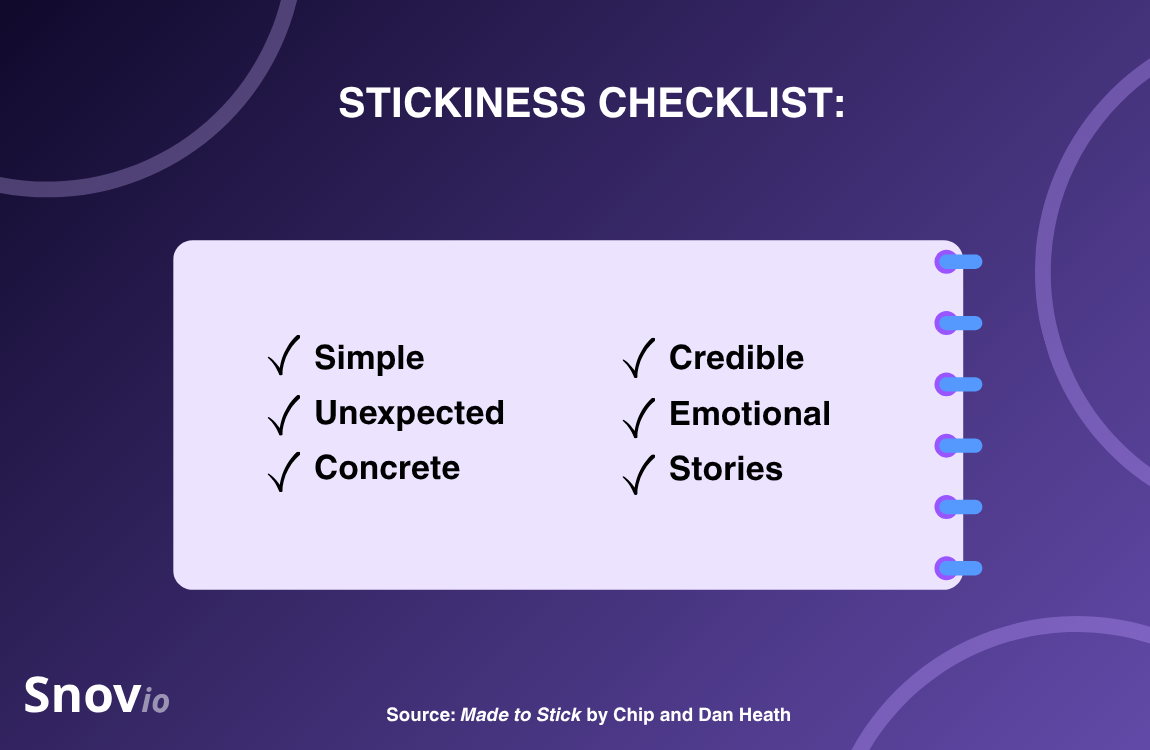
The SUCCES framework stands for:
- Simplicity
There is no need for walls of text and overly complicated language. LinkedIn connection messages shouldn’t be an exception to the widespread “short and sweet” rule.
- Unexpectedness
A super personalized LinkedIn connection message might take some extra time. Yet, the efforts could pay off in the end. Point out something not as obvious about your leads’ work or share an unusual perspective about their project.
- Concreteness
Being specific and transparent about the reasons you want to connect helps avoid any impression of generic outreach.
- Credibility
Trust is a cornerstone of any meaningful connection, which is why it’s so crucial to establish it. If suitable, share your experience or credentials in your LinkedIn connection messages.
- Emotions
As humans, we can’t remove emotions from the equation, even in LinkedIn outreach. Try to connect on this level by sharing how their ideas have made you feel.
- Stories
Making your LinkedIn connection messages feel relatable by sharing a story is also a good idea. Think of a time you’ve experienced something similar to your potential lead or have faced a challenge they’ve mentioned.
We’ve prepared even more tips to help you make your LinkedIn connection messages more impactful. Let’s move on to them.
Look for common ground
Ever heard about the mere exposure effect? It’s a human tendency to develop preferences for something based solely on recognition. Put simply, familiarity breeds comfort. We bet you’ve experienced that yourself a number of times.
In the context of LinkedIn, this means that building trust is way easier with people who share something in common with you. This could be a mutual connection, a shared interest, or anything else that creates a sense of connection and familiarity. Once this trust is established, people become more likely to accept your LinkedIn connection request.
Personalize your LinkedIn connection messages
The best LinkedIn connection request messages may vary, but personalization is always king. Knowing your audience means reaching out to potential leads in a way that speaks directly to them. After all, a financial advisor is probably not the right target for your posts on social media trends.
|
💡Did you know? 95% of marketers claim that personalization has a significant impact on their strategies. |
In our opinion, LinkedIn is one of the best places to help you ensure that outreach campaigns are personalized. Basically, it’s a vast pool of data on people’s career choices, educational backgrounds, and professional interests at your fingertips. We recommend using this data primarily to pinpoint your potential leads and those who align with your goals and offerings.
Sure, personalizing your LinkedIn message requests takes time, but the results won’t keep you waiting. You can mention how you know them, acknowledge their successes, and bring up shared interests.
Keep in mind that personalization goes far beyond mentioning leads’ names. A quality connection request message is all about relevancy and attention to people’s needs.
💡Automation hack
Personalize your outreach messages in bulk using LinkedIn automation.
Address people by name and mention their roles, industries, companies, and more. And all this irrespective of how many people you’re reaching out to at once.
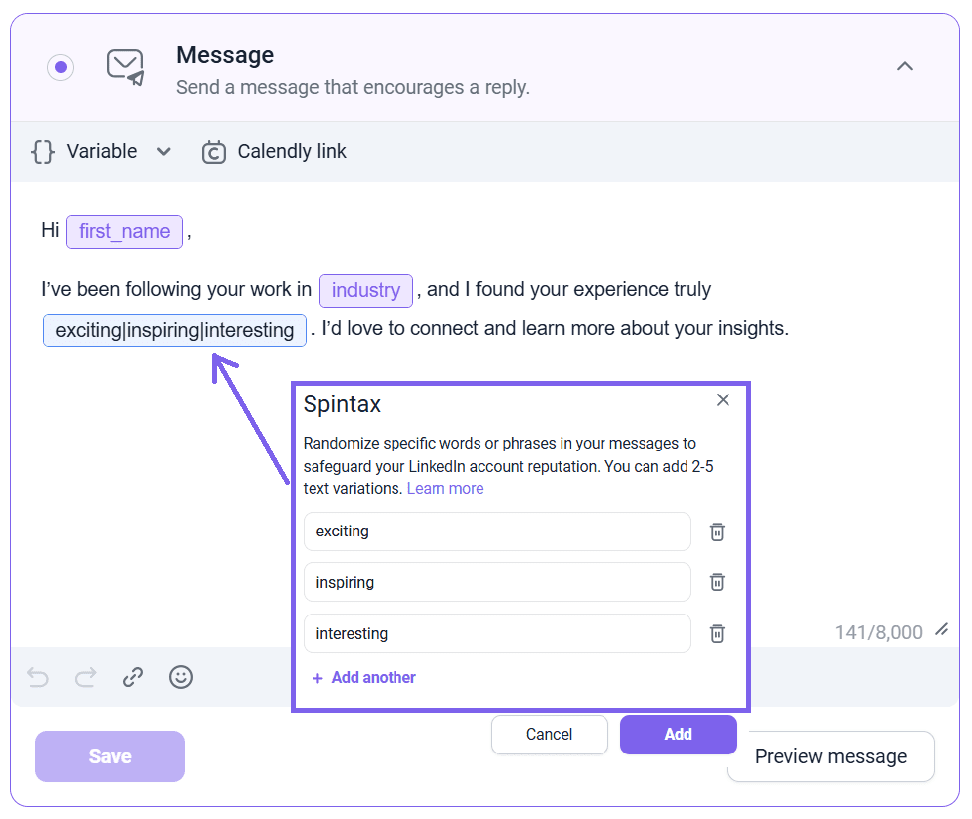
Also, implement the Dynamic content feature to tailor your messages to any client.
Or, use Spintax to easily create multiple unique message variations by mixing various words and phrases.
Keep your LinkedIn connection requests professional
Sure, using LinkedIn for personalization is a smart move, but it’s equally important to keep your messages professional. In your outreach, we recommend not including too much information related to your leads’ personal lives. People are entitled to their privacy, and failing to respect it can skew the odds of building meaningful connections.
The tone of your LinkedIn connection request messages is also a crucial point to consider. To ensure your leads feel comfortable, aim to strike a balance between friendly and professional.
If your LinkedIn message comes across as overly casual, people might start questioning your seriousness. At the same time, too formal communication might be perceived as unnecessarily cold and impersonal.
Also, adjust your tone with the following factors in mind:
- Industry communication norms
- Lead’s professional position
- Context of your relationship
Build a connection first
Reciprocity hasn’t been lost somewhere along the way; it’s still very much alive. In its essence, it’s a core social norm and human principle that makes us willing to reciprocate acts of kindness and favors.
This need to balance things out is often leveraged as part of marketing campaigns. Such strategies are carefully designed to get people to move down the sales funnel, and the goal here is, obviously, not immediate sales.
This can take on many forms, such as free guides, templates, insights, etc. Generally, giving away things of value is usually received positively and makes people more inclined to engage.
So, before you send your next LinkedIn connection message, think of ways you can bring something useful to the table. Put yourself in your leads’ shoes and reflect on what would prompt you to engage.
Consider sharing helpful insights or resources, showing interest in individuals’ profiles, etc. But remember to keep your outreach messages genuine; people can smell sales pitches a mile away.
Skipping the initial touchpoints
We recommend laying the groundwork before launching your outreach campaigns. Try breaking the ice by engaging with your potential leads’ content: like their posts and leave a thoughtful comment. This can help make your efforts feel more genuine and create a stronger connection.
Mistakes that raise red flags in LinkedIn connection messages
There are some common pitfalls we recommend that you steer clear of when launching your LinkedIn outreach.
Not optimizing your LinkedIn profile
LinkedIn optimization is an ongoing process of establishing your personal brand. It’s a continuous story of your professional path that should evolve alongside your career growth.
So, before you send your next LinkedIn connection message, make sure your profile looks well-polished. It should obviously have quality pictures, relevant descriptions, and detailed experience.
Plus, strong LinkedIn profiles usually go beyond the basics. They reflect people’s value, growth, and expertise, establishing a deeper connection with leads.
Remember, your account is the first thing people see when you’re trying to connect. The first impression, more often than not, can make it or break it. In other words, it can play a huge role in whether your connection requests get accepted.
Skipping the initial touchpoints
We recommend laying the groundwork before launching your outreach campaigns. Try breaking the ice by engaging with your potential leads’ content: like their posts and leave a thoughtful comment. This can help make your efforts feel more genuine and create a stronger connection.
|
📍Bonus tip LinkedIn constantly monitors for any suspicious activity. So, when choosing an automation tool, we strongly advise paying close attention to its safety features. Snov.io takes care of your data security by providing the following measures:
And much more! |
20+ best LinkedIn connection request message templates
Still struggling to put your thoughts together? No worries; we’ve gathered effective LinkedIn connection message templates for each occasion.
LinkedIn connection request message templates for professional networking
Connect with your target in a way that’s meaningful using these templates:
- Hi [FirstName],
I came across your project in [industry], and it really caught my attention. Let’s connect about [topic].
- Hi [FirstName],
Hello [FirstName], I’ve been following your career in [field] and I’m genuinely impressed. Would love to chat about [topic] some time.
- Hello [FirstName],
Your take on [field] really stands out. I’d love to connect and hear more about your thoughts on [specific area].
- Hi [FirstName],
[Hi FirstName,] I saw what you’re doing with [project] and it’s exactly what I’m interested in. Mind if we connect to chat about [related topic]?
- Hello [FirstName],
The way you’re approaching [industry] is so refreshing. Connecting to explore [related solution].
LinkedIn connection request message templates for job seekers
These templates can help you make a solid first impression:
- Hi [FirstName],
I see you’re looking for a [position] at [company]. My experience with [technology/skill] could benefit your [team/division].
- Hi [FirstName],
I’m exploring new roles in [industry]. Your team’s work on [project] aligns with my background.
- Hello [FirstName],
Your company’s approach to [specific challenge] impressed me. Would my experience in [area] fit your team?
- Hello [FirstName],
That campaign your marketing team did for [company] was brilliant! My skills in [area] could complement your strategy.
- Hello [FirstName],
Your [company] is doing groundbreaking work in [field]. My experience with [technology] could advance your [specific project].
Personalized LinkedIn connection request message templates
Make your outreach feel more genuine with these templates:
- Hi [FirstName],
I just read your post about [topic] and couldn’t stop thinking about it. Let’s discuss [related subject] further.
- Hello [FirstName],
I’ve been following your work on [project], and it’s impressive. Would love to hear more about your approach to [related topic].
- Hello [FirstName],
Your post about [issue] really resonated with me. I’ve been thinking about similar things lately. Let’s discuss [solution].
- Hi [FirstName],
Your article on [topic] was spot-on about [issue]. I’d love to share some insights on similar challenges.
- Hello [FirstName],
Your post about [issue] really resonated with me. I’d love to connect and brainstorm some [solution] ideas.
Best LinkedIn connection request messages for sales
Templates that aren’t too sales-y right away:
- Hello [FirstName],
Your work at [company] caught my eye. Seems we’re both focused on [area]. Thought it might be worth connecting to share approaches.
- Hello [FirstName],
I noticed your team at [company] has been tackling [challenge]. I’ve gathered some insights that might help. Mind connecting?
- Hi [FirstName],
I’ve been following your team’s work on [topic] at [company]. Let’s connect and share insights on making [task] more efficient.
- Hi [FirstName],
I see you’re working on [challenge] at [company]. I’d love to exchange tips on what’s working.
LinkedIn connection message templates for events, communities, and alumni
Templates for connecting with those you already know or have something in common:
- Hello [FirstName],
Your comment in [community] about [topic] made me rethink my whole approach. Would love to connect and hear more of your thoughts.
- Hi [FirstName],
Fellow [university] grad here! I’d love to hear about your journey in [industry].
How to cancel a pending LinkedIn connection request?
As we mentioned above, LinkedIn takes people’s activity seriously and is very vigilant about any suspicious actions. If the platform detects yours as such, your account might be at stake. So, canceling pending LinkedIn connection requests is as important as sending them.
With Snov.io, you can easily track your connection requests and withdraw them both manually and automatically.
To view them, just go to the Campaigns tab and then click Connection requests, located in the submenu on the left.
If you want to delete them manually, you need to first select the LinkedIn profile. At this point, you can see the number of all pending requests next to your account name on the left.
Now, you can quickly withdraw them one by one by checking the boxes next to the prospects and clicking Withdraw selected. To clear the entire list, click the square icon in the top left and select All requests.
To withdraw LinkedIn connection requests automatically, just enable automated mode by switching the toggle at the top left of the page.
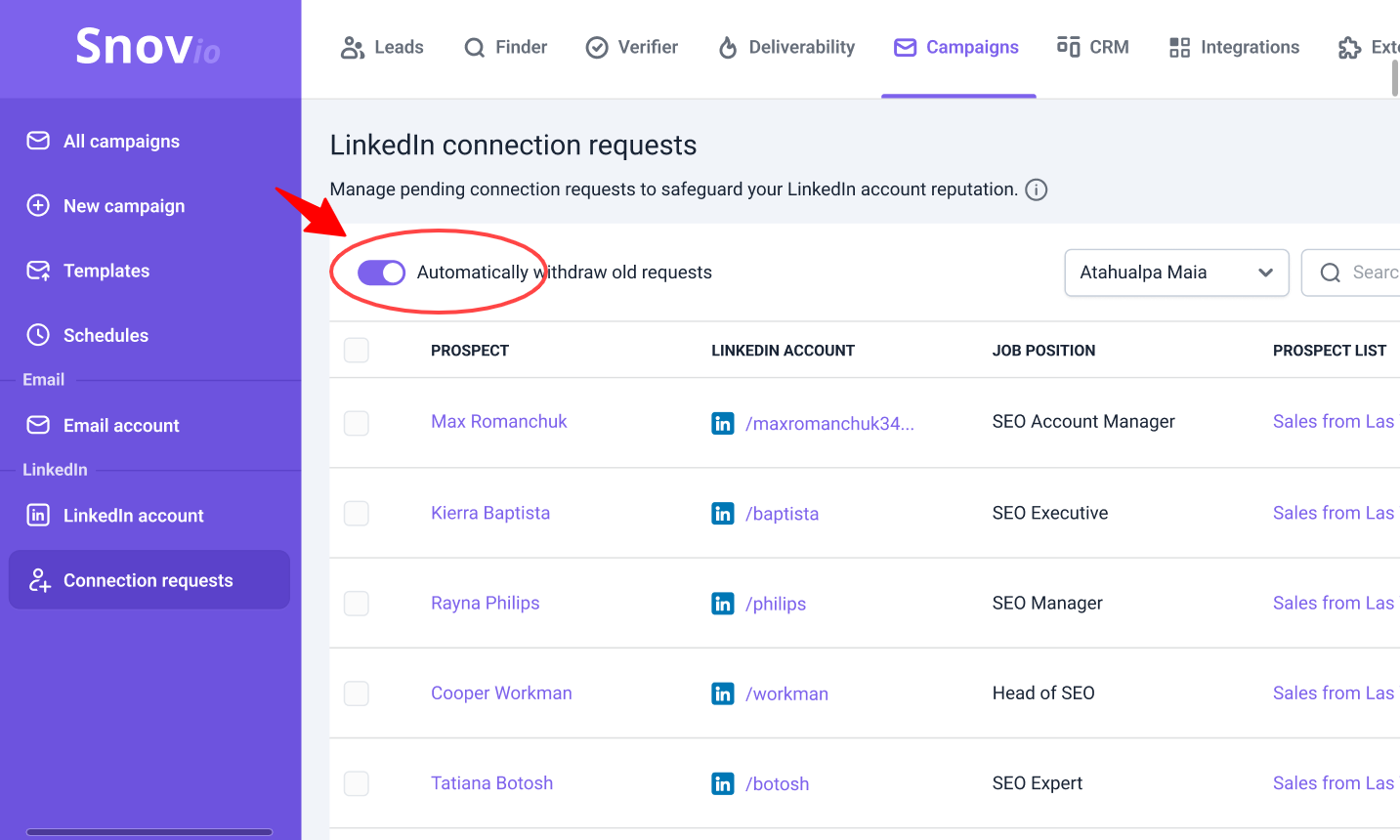
To set this up, enter the maximum number of pending requests each account can have. This limit will apply to all connected LinkedIn accounts.
|
📌 Note Maintaining good pending-requests hygiene ensures the safety of your LinkedIn profile. For this reason, we recommend keeping them below 500 per account. Also, remember that once your connection request is deleted, you can’t send another one to the same lead for 3 weeks. |
Key takeaways
Now that we’ve discovered how to write a connection message on LinkedIn, it’s your turn to try. Of course, creating a sure-fire connection request on LinkedIn is by no means an exact science. You’ll probably go through a lot of trial and error before you find your groove.
What’s more, a strategy that can net you an instant connection request acceptance with one prospect might not necessarily work with another lead. To adapt effectively, focus on concreteness and personalization, and delegate other outreach steps to Snov.io.


